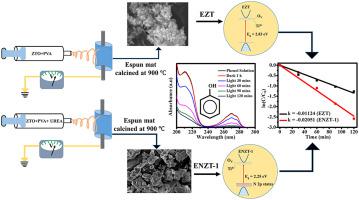Journal of Physics and Chemistry of Solids ( IF 4.3 ) Pub Date : 2021-06-13 , DOI: 10.1016/j.jpcs.2021.110221 Somendra Singh , Shama Perween , Amit Ranjan

|
Hexagonal phase of Zinc titanate (ZTO) powder obtained by calcining the electrospun sol in the temperature range of 700–800 °C has shown bandgap in the visible region (Perween and Ranjan, 2017) [1]. Owing to this, ZTO can be considered as a candidate material for visible light induced photocatalysis applications, and therefore can serve as a suitable alternative for solar radiation aided treatment of environmental pollutants. Doping ZTO with a suitable dopant atom such as nitrogen can further reduce its bandgap and thereby enhance the efficacy of its catalytic response to solar light. Here we report successful incorporation of nitrogen in zinc titanate with varying fraction of nitrogen using urea as a nitrogen source. Nitrogen incorporation leads to reduction in the bandgap, and thereby improvement in its visible light induced catalytic performance of ZTO towards the degradation of phenol. Presence of nitrogen also promotes the formation of the high-temperature phase of cubic Zn2TiO4. Nitrogen incorporated ZTO (N-ZTO) nanoparticles lead to a reduction in the bandgap from 2.83 eV in un-nitrogenated samples to 2.25 eV in nitrogenated ZTO. A substitutional doping of nitrogen is confirmed by various characterization techniques such as XPS, Raman, and FT-IR which show the presence of Ti–N bonds. Nitrogen incorporation in electrospun samples yields high surface area (122 m2/g) upon calcination, generating surface states that play important role in enhancing the sensitivity to visible light in samples prepared by our technique. The rate constant (k) of the phenol degradation reaction increased to 0.02051 min−1 with N-ZTO as compared to 0.00330 min−1 obtained with ZTO.
中文翻译:

通过氮掺杂增强溶胶电纺钛酸锌纳米粉体中可见光诱导的光催化活性
通过在 700–800 °C 的温度范围内煅烧电纺溶胶获得的钛酸锌 (ZTO) 粉末的六方相在可见光区显示出带隙 (Perween and Ranjan, 2017) [1]。因此,ZTO可以被认为是可见光诱导光催化应用的候选材料,因此可以作为太阳辐射辅助处理环境污染物的合适替代品。用合适的掺杂原子(如氮)掺杂 ZTO 可以进一步降低其带隙,从而提高其对太阳光的催化响应效率。在这里,我们报告使用尿素作为氮源,成功地将氮掺入钛酸锌中,并具有不同比例的氮。氮掺入导致带隙减小,从而提高其可见光诱导的ZTO对苯酚降解的催化性能。氮的存在也促进了立方锌高温相的形成2 TiO 4。掺入氮的 ZTO (N-ZTO) 纳米粒子导致带隙从未氮化样品中的 2.83 eV 降低到氮化 ZTO 中的 2.25 eV。通过各种表征技术(如 XPS、拉曼和 FT-IR)证实了氮的置换掺杂,这些技术表明存在 Ti-N 键。电纺样品中的氮掺入在煅烧时产生高表面积 (122 m 2 /g),产生的表面状态在增强由我们的技术制备的样品中对可见光的敏感性方面起着重要作用。与使用ZTO 获得的0.00330 min -1相比,使用N-ZTO的苯酚降解反应的速率常数( k ) 增加到0.02051 min -1。









































 京公网安备 11010802027423号
京公网安备 11010802027423号